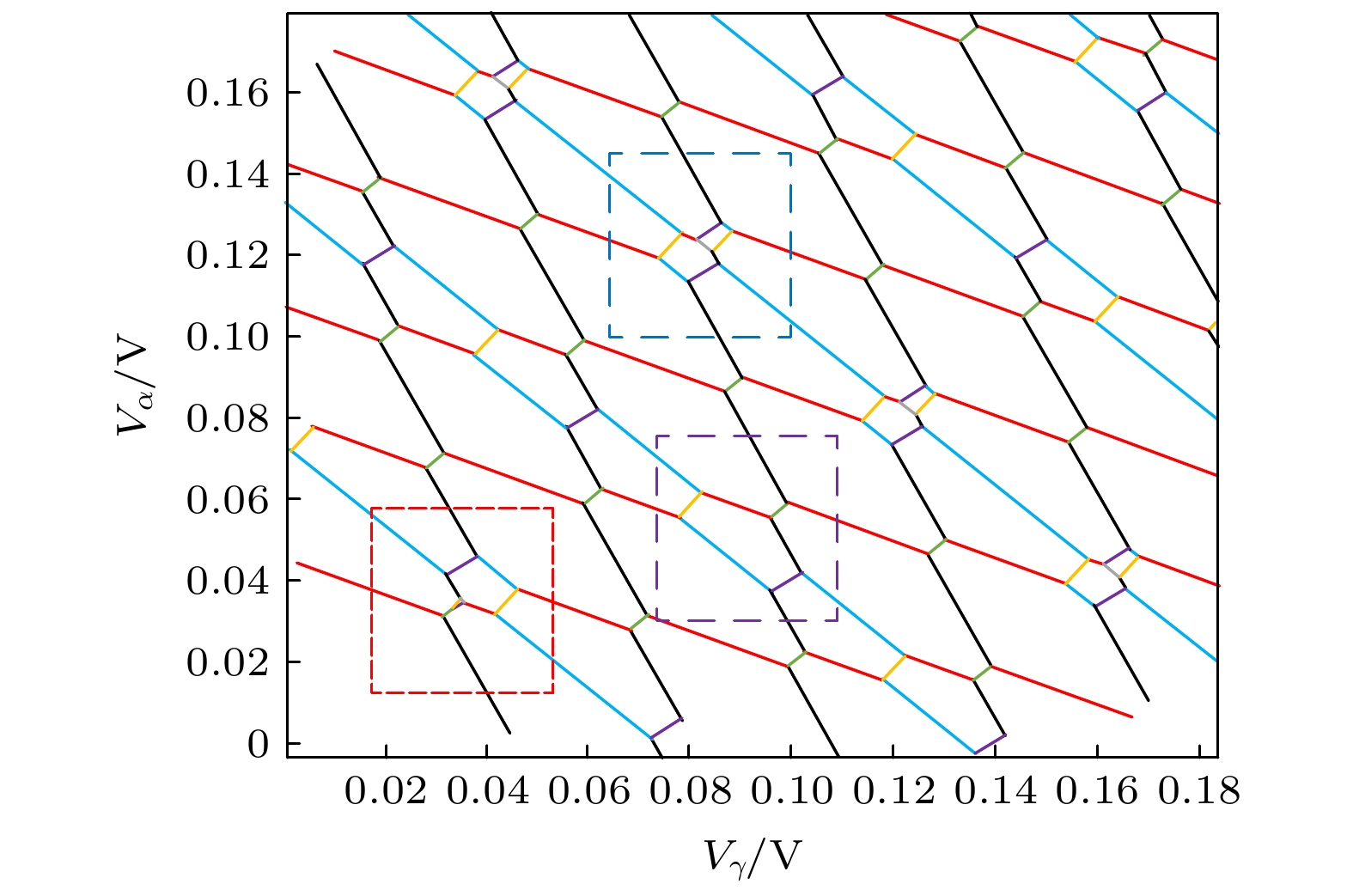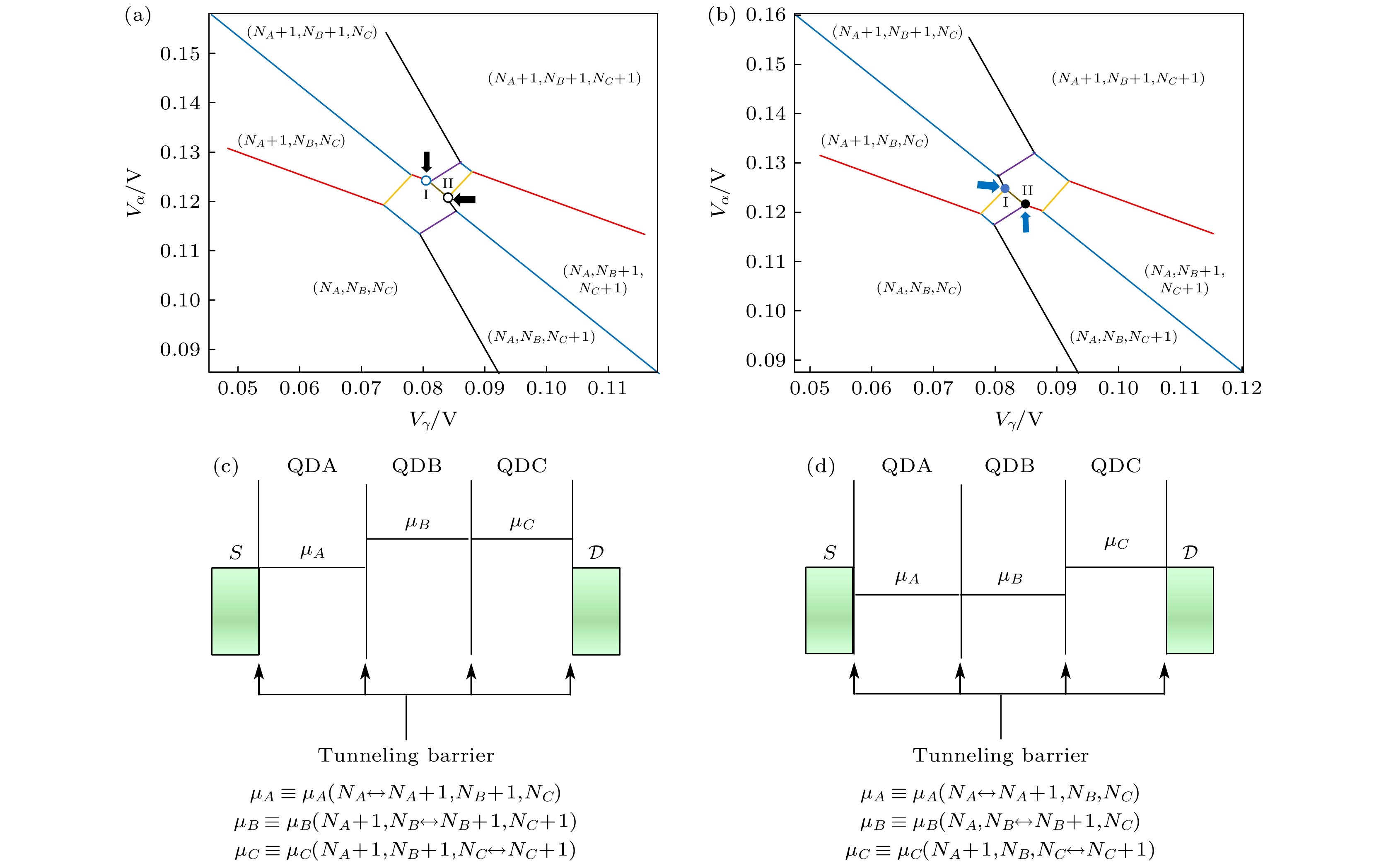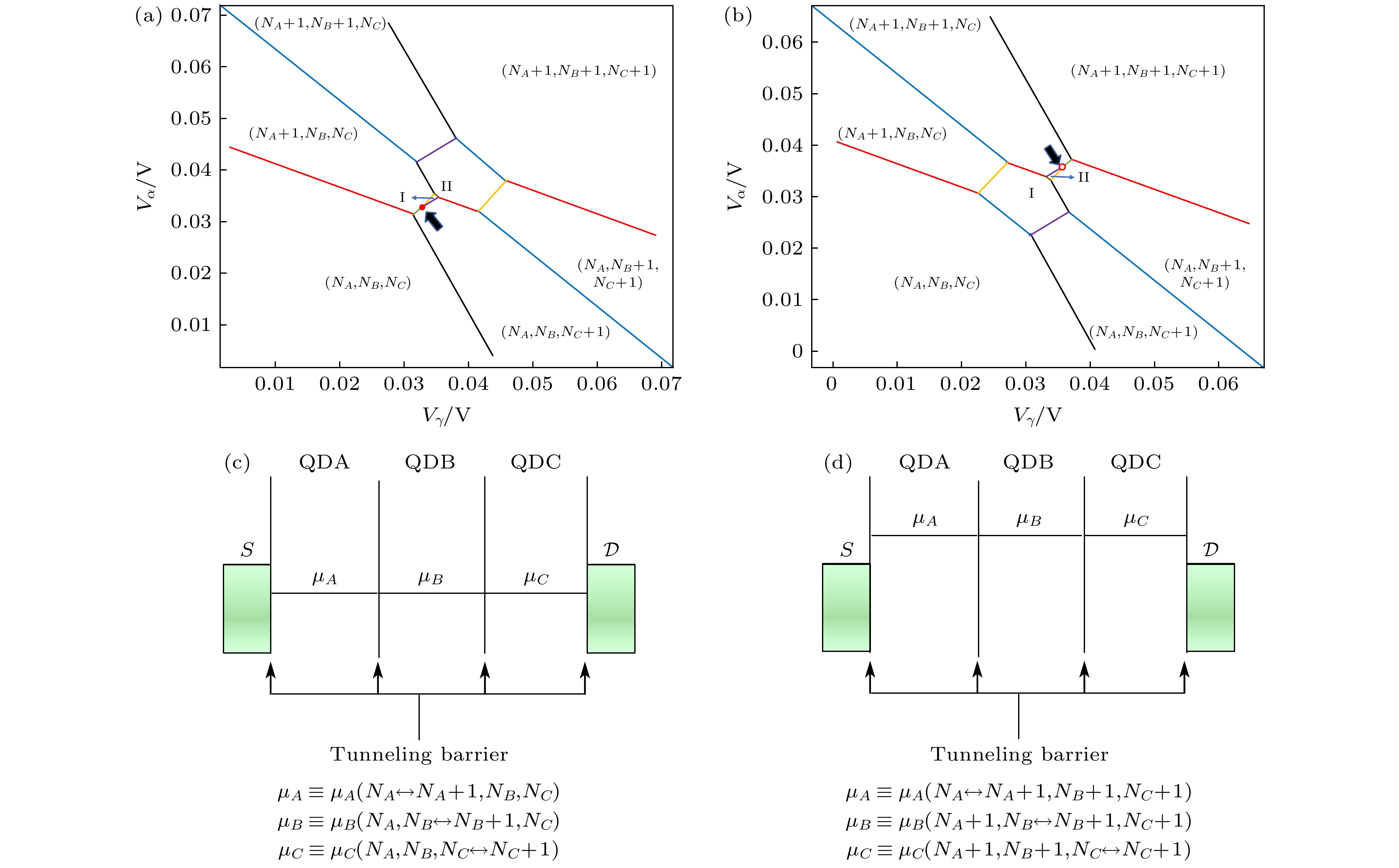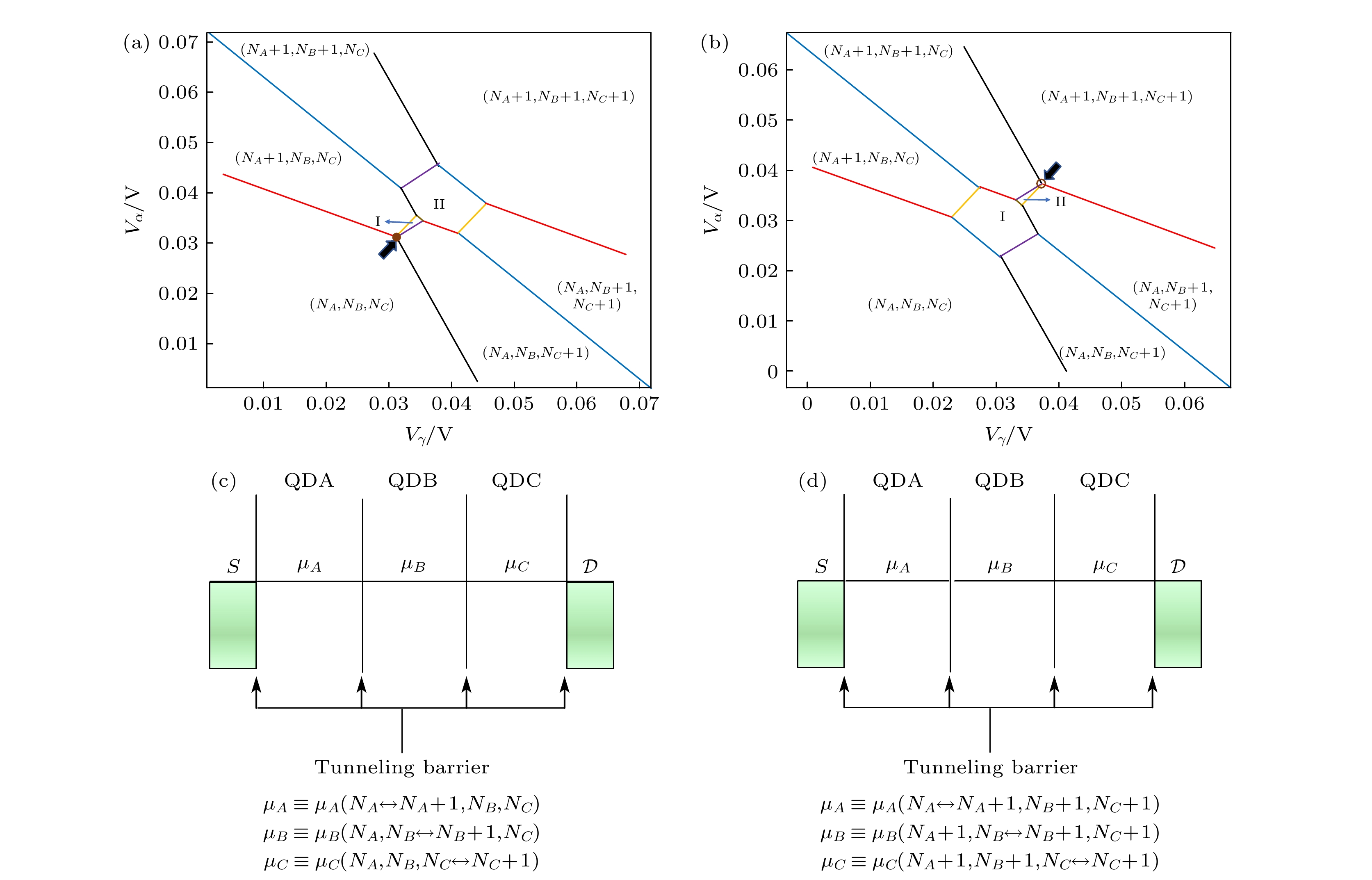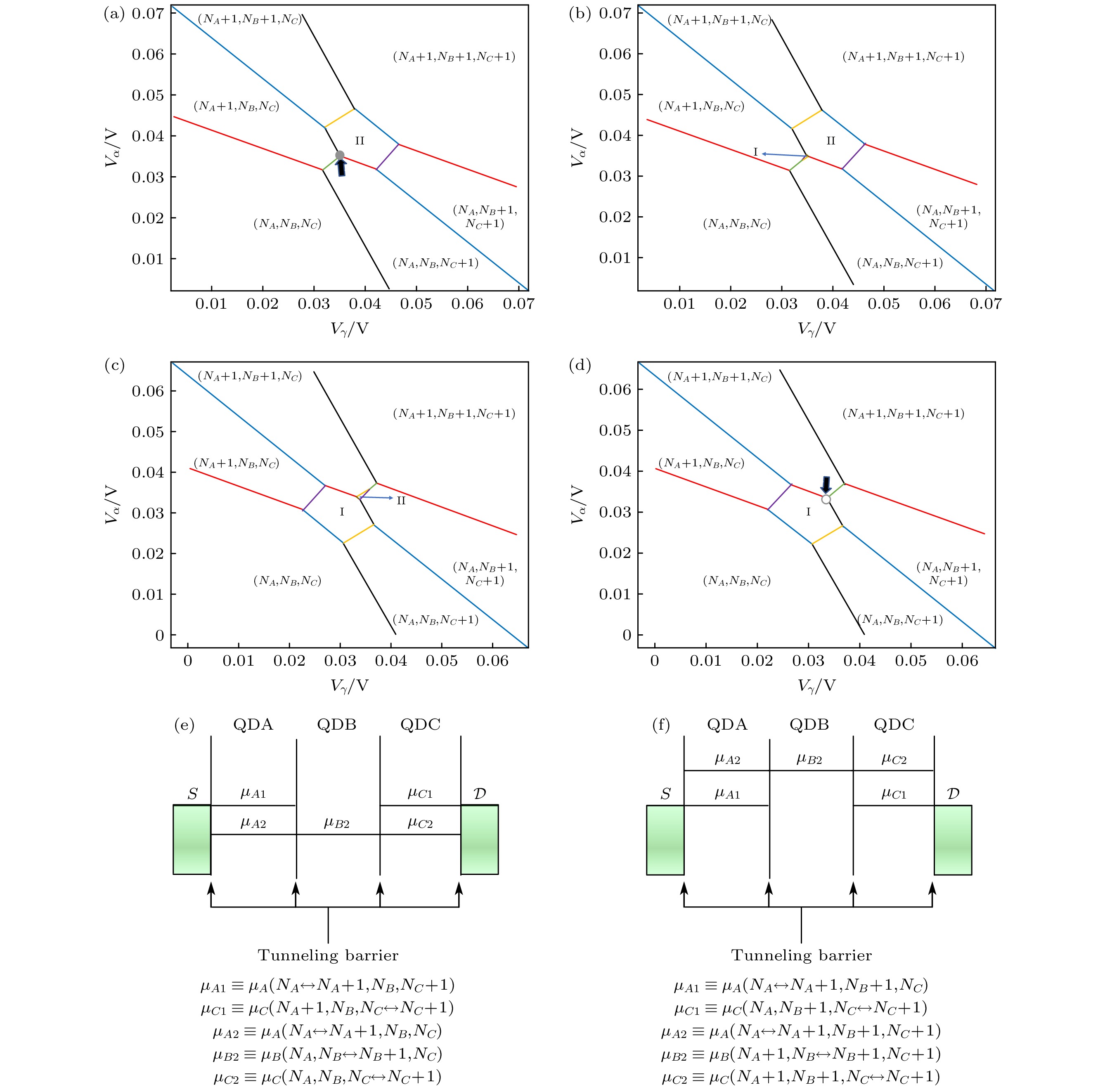-
串联耦合三量子点(serial triple quantum dots, STQD)体系在近十年来受到人们的广泛关注, 这不仅是提高量子点集成度的一个必然过程, 更重要的是可以利用STQD中一些特定的电荷占据态来实现自旋量子比特的快速全电学调控. 本文运用常相互作用模型, 导出了与外部可观测物理量相关的STQD电化学势, 借助数值模拟计算得到STQD在不同中间栅电压下的线性输运二维电荷稳态图(简称二维稳态图), 着重研究STQD的各种电荷占据态之间的能量简并点(简称能量简并点), 结合实验将STQD中的能量简并点归纳为三种类型, 对这些能量简并点的深入理解可以指导实验高效地寻找STQD体系中适合量子计算的工作区.
Serial triple quantum dot (STQD) systems have received extensive attention in the past decade, not only because quantum dot scaling up is an indispensable ingredient for integrations, but also due to the fact that specific charge states of STQD can be employed to achieve fast full-electrical manipulation of spin qubits. For the latter, a comprehensive understanding of the relationship between neighboring charge occupancy states of STQD is essential for three-electron exchange-only spin qubit-based quantum computations. Charge stability diagram is usually employed to map out the charge occupation states about the plunger gate voltages of STQDs and to study the degeneracy among charge occupation states. Experimentally, two- rather than three-dimensional charge stability diagram was obtained in a lot of early studies by keeping one of plunger gates unchanged to reduce complexity. The obtained two-dimensional diagram can only provide limited information and is subject to blurred boundary of charge occupation states due to the low tunneling current and the energy level broading effects. It is, therefore, challenge to searching for the working points where quantum manipulation can be performed promptly and accurately. In principle, three-dimensional charge occupation stability diagram can be efficiently constructed by numerical simulations based on constant interaction (CI) model. In this study, we calculate the electrochemical potential of STQD about three plunger gate voltages by using the CI model-based capacitance network to reproduce any desired two-dimensional charge stability diagram. The simulated diagram not only well accords with the diagrams obtained from the early experimental data of STQD, but also provides high clarity of the charge state boundaries with tunable parameters. The systematical study of two-dimensional charge stability diagram reviews the energy degeneracy triple and quadruple points of STQD charge occupation states and concludes the energy degeneracy points in three types to compare with experimental data. For each of the energy degeneracy points, we discuss both the electron and hole transport by using the electrochemical potential alignment schematics. We reveal the common and unique triple points of STQD in comparison with those of double quantum dot. The quadruple points of STQD are also addressed in the manipulation of quantum cellular automata and quantum logical gate. The comprehensive understanding of these energy degeneracy points can efficiently guide experiments to build an optimal working point of the STQD system for quantum computations and simulations. -
Keywords:
- serial triple quantum dots /
- two-dimensional stability diagram /
- constant interaction model
[1] 范桁 2018 物理学报 67 120301
 Google Scholar
Google Scholar
Fan H 2018 Acta Phys. Sin. 67 120301
 Google Scholar
Google Scholar
[2] Georgescu I 2020 Nat. Rev. Phys. 2 666
 Google Scholar
Google Scholar
[3] De Leon N P, Itoh K M, Kim D, Mehta K K, Northup T E, Paik H, Palmer B S, Samarth N, Sangtawesin S, Steuerman D W 2021 Science 372 253
[4] Loss D, DiVincenzo D P 1998 Phys. Rev. A. 57 120
 Google Scholar
Google Scholar
[5] Zhang X, Li H O, Wang K, Cao G, Xiao M, Guo G P 2018 Chin. Phys. B. 27 020305
 Google Scholar
Google Scholar
[6] DiVincenzo D P 2005 Science 309 217
 Google Scholar
Google Scholar
[7] Chatterjee A, Stevenson P, De Franceschi S, Morello A, de Leon N P, Kuemmeth F 2021 Nat. Rev. Phys. 3 157
 Google Scholar
Google Scholar
[8] Elzerman J M, Hanson R, Willems Van Beveren L H, Witkamp B, Vandersypen L M K, Kouwenhoven L P 2004 Nature 430 431
 Google Scholar
Google Scholar
[9] Petta J R, Johnson A C, Taylor J M, et al. 2005 Science 309 2180
 Google Scholar
Google Scholar
[10] Koppens F H L, Buizert C, Tielrooij K J, et al. 2006 Nature 442 766
 Google Scholar
Google Scholar
[11] Nowack K C, Koppens F H L, Nazarov Yu V, Vandersypen L M K 2007 Nature 318 1430
[12] Cao G, Li H O, Tu T, Wang L, Zhou C, Xiao M, Guo G C, Jiang H W, Guo G P 2013 Nat. Commun. 4 1401
 Google Scholar
Google Scholar
[13] Chen B B, Wang B C, Cao G, Li H O, Xiao M, Guo G P 2017 Sci. Bull. 2 712
[14] DiVincenzo D P, Bacon D, Kempe J, Burkard G, Whaley K B 2000 Nature 408 339
 Google Scholar
Google Scholar
[15] Russ M, Burkard G 2017 J. Phys. Condens. Matter 29 393001
 Google Scholar
Google Scholar
[16] Gaudreau L, Studenikin S A, Sachrajda A S, Zawadzki P, Kam A 2006 Phys. Rev. Lett. 97 036807
 Google Scholar
Google Scholar
[17] Granger G, Gaudreau L, Kam A, et al. 2010 Phys. Rev. B 82 075304
 Google Scholar
Google Scholar
[18] Medford J, Beil J, Taylor J M, et al. 2013 Nat. Nanotechnol. 8 654
 Google Scholar
Google Scholar
[19] Wang B C, Cao G, Li H O, Xiao M, Guo G C, Hu X D, Jing H W, Guo G P 2017 Phys. Rev. Appl. 8 064035
 Google Scholar
Google Scholar
[20] Schröer D, Greentree A D, Gaudreau L, Eberl K, Hollenberg L C L, Kotthaus J P, Ludwig S 2007 Phys. Rev. B 76 075306
 Google Scholar
Google Scholar
[21] Rogge M C, Haug R J 2009 New J. Phys. 11 113037
 Google Scholar
Google Scholar
[22] Wang J Y, Huang S Y, Huang G Y, Pan D, Zhao J H, Xu H Q. 2017 Nano Lett. 17 4158
 Google Scholar
Google Scholar
[23] Hanson R, Kouwenhoven L P, Petta J R, Tarucha S, Vandersypen L M K 2007 Rev. Mod. Phys. 79 1217
 Google Scholar
Google Scholar
[24] 曾谨言 2013 量子力学(卷I) 第五版 (北京: 科学出版社) 第81页-第83页
Zeng J Y 2013 Quantum Mechanics (Vol. 1) (5th Ed.) (Beijing: Science Press) pp81—83 (in Chinese)
[25] Van der Wiel W G, De Franceschi S, Elzerman J M, Fujisawa T, Tarucha S, Kouwenhoven L P 2003 Rev. Mod. Phys. 75 1
[26] 蔡圣善, 朱耘, 徐建军 2002 电动力学 (第二版) (高等教育出版社) 第65页
Cai S S, Zhu Y, X J J 2002 Electrodynamics (2nd Ed.) (Beijing: Higher Education Press) p65 (in Chinese)
[27] Mu J W, Huang S Y, Liu Z H, Li W J, Wang J Y, Pan D, Huang G Y, Chen Y J, Zhao J H, Xu H Q 2021 Nanoscale 13 3983
 Google Scholar
Google Scholar
[28] Pierre M, Hofheinz M, Jehl X, Sanquer M, Molas G, Vinet M, Deleonibus S 2009 Eur. Phys. J. B 70 475
 Google Scholar
Google Scholar
[29] Elzerman J M, Hanson R, Greidanus J S, Willems van Beveren L H, De Franceschi S, Vandersypen L M K, Tarucha S, Kouwenhoven L P 2003 Phys. Rev. B 67 161308
 Google Scholar
Google Scholar
[30] Wang X M, Huang S Y, Wang J Y, Pan D, Zhao J H, Xu H Q 2021 Nanoscale 13 1048
 Google Scholar
Google Scholar
[31] Li W J, Mu J W, Huang S Y, Pan D, Zhao J H, Xu H Q 2020 Appl. Phys. Lett. 117 262102
 Google Scholar
Google Scholar
[32] Takakura T, Pioro-Ladrière M, Obata T, Shin Y S, Brunner R, Yoshida K, Taniyama T, Tarucha S 2010 Appl. Phys. Lett. 97 212104
 Google Scholar
Google Scholar
[33] Noiri A, Yoneda J, Nakajima T, et al. 2016 Appl. Phys. Lett. 108 153101
 Google Scholar
Google Scholar
[34] Greentree A D, Cole J H, Hamilton A R, Hollenberg L C L 2004 Phys. Rev. B 70 235317
 Google Scholar
Google Scholar
[35] Van Diepen C J, Hsiao T K, Mukhopadhyay U, Reichl C, Wegscheider W, Vandersypen L M K 2021 Nat. Commun. 12 77
 Google Scholar
Google Scholar
[36] Zajac D M, Sigillito A J, Russ M, Borjans F, Taylor J M, Burkard G, Petta J R, 2018 Science 359 439
[37] Gullans M J, Petta J R 2019 Phys. Rev. B 100 085419
 Google Scholar
Google Scholar
-
图 3 在中间量子点栅压Vβ = 0.0106 V时的STQD的二维稳态图. 其中红色线、蓝色线和黑色线分别代表了量子点A, B, C的充电线; 黄色线、紫色线以及绿色线分别代表了电荷在量子点A和B、量子点B和C以及量子点A和C之间的电荷重分布线; 灰色线代表了STQD点独有的输运过程
Fig. 3. Low source-drain bias charge stability diagram of STQD at Vβ = 0.0106 V. Red-, blue- and black-colored lines represent the charging line of quantum dot A, B and C, respectively; Yellow-, purple- and green-colored lines represent charge reconfiguration lines between quantum dots A and B, B and C, and A and C, respectively; Gray-colored line represents a unique transport process of STQD.
图 4 第一类三点. 其中I区指代的是
$ ({N}_{A}, {N}_{B}+1, {N}_{C}) $ 区域 (a) 对应了图3中的紫色虚线方框, 这里$ {V}_{\beta }=0.0106\rm{V}. $ 绿色箭头表示$ A $ 和$ C $ 两个量子点电化学势对齐, 紫色箭头表示$ B $ 和$ C $ 两个量子点电化学势对齐, 黄色箭头表示$ A $ 和$ B $ 两个量子点电化学势对齐, 实心点对应了电子型输运, 空心点对应了空穴型输运; (b) 图(a)中绿色实心点对应的电化学势对齐情况, QDA, QDB和QDC分别指代的是量子点A, B和C; (c) 图(a)中绿色空心点对应的电化学势对齐情况, QDA, QDB和QDC分别指代的是量子点A, B和CFig. 4. The first type of triple points. Region I refers to
$ ({N}_{A}, {N}_{B}+1, {N}_{C}) $ charge state: (a) Zoom-in of the purple box in Fig. 3 at$ {V}_{\beta }=0.0106\rm{V} $ .The green-colored arrow indicates the alignment between electrochemical potential of dot A and dot C. The purple-colored arrow indicates the alignment between electrochemical potential of dot B and dot C. The yellow-colored arrow indicates the alignment between electrochemical potential of dot A and dot B. Solid dots correspond to electron transport, and open dots correspond to hole transport; (b) the alignment of electrochemical potential of green-colored solid dot in Figure (a). QDA, QDB and QDC refer to quantum dot A, B and C, respectively; (c) the alignment of electrochemical potential of green-colored open dot in Figure (a). QDA, QDB and QDC refer to quantum dot A, B and C, respectively.图 5 第二类三点, 其中I区指代的是
$ ({N}_{A}, {N}_{B}+1, {N}_{C}) $ 区域, II区指代的是$ ({N}_{A}+1, {N}_{B}, {N}_{C}+1) $ 区域 (a) 对应了图3中的蓝色虚线方框, 这里$ {V}_{\beta }=0.0106\;\rm{V} $ . 箭头指代的空心点标示了在该三点处是空穴型输运; (b)$ {V}_{\beta }=0.0078\;\rm{V} $ . 箭头指代的实心点标示了在该三点处是电子型输运. 图(b)对应二维稳态图的$ {V}_{\beta } $ 值小于图(a)的$ {V}_{\beta } $ 值; (c) 图(a)蓝色空心点对应的电化学势对齐情况, QDA, QDB和QDC分别指代的是量子点A, B和C; (d) 图(b)蓝色实心点对应的电化学势对齐情况, QDA, QDB和QDC分别指代的是量子点A, B和CFig. 5. The second type of triple points. Region I refers to
$ ({N}_{A}, {N}_{B}+1, {N}_{C}) $ charge state and region II refers to$ ({N}_{A}+1, {N}_{B}, $ $ {N}_{C}+1) $ charge state: (a) Zoom-in of the blue-colored box in Fig. 3 at$ {V}_{\beta }=0.0106\;\rm{V} $ .The two arrows indicate triple points of hole transport; (b) at$ {V}_{\beta }=0.0078\;\rm{V} $ . The two arrows indicate triple points of electron transport.$ {V}_{\beta } $ of (b) is smaller than that of Figure (a); (c) the alignment of electrochemical potential indicated by the blue-colored open dot in Figure (a). QDA, QDB and QDC refer to quantum dot A, B and C, respectively; (d) the alignment of electrochemical potential indicated by the blue-colored solid dot in Figure (b). QDA, QDB and QDC refer to quantum dot A, B and C, respectively图 6 第三类三点, 其中I区指代的是
$ ({N}_{A}, {N}_{B}+1, {N}_{C}) $ 区域, II区指代的是$ ({N}_{A}+1, {N}_{B}, {N}_{C}+1) $ 区域 (a) 对应了图3中的红色虚线方框, 这里$ {V}_{\beta }=0.0106\;\rm{V} $ . 箭头指代的实心点标示了在该三点处是电子型输运; (b)$ {V}_{\beta }=0.0167\;\rm{V} $ . 箭头指代的空心点标示了在该三点处是空穴型输运. 图(b)对应二维稳态图的$ {V}_{\beta } $ 值大于图(a)的$ {V}_{\beta } $ 值; (c) 图(a)红色实心点对应的电化学势对齐情况, QDA, QDB和QDC分别指代的是量子点A, B和C. (d) 图(b)红色空心点对应的电化学势对齐情况, QDA、QDB和QDC分别指代的是量子点A, B和CFig. 6. The third type of triple points. Region I refers to
$ ({N}_{A}, {N}_{B}+1, {N}_{C}) $ charge state and region II refers to$ ({N}_{A}+1, {N}_{B}, $ $ {N}_{C}+1) $ charge state; (a) Zoom-in of the red-colored box in Fig. 3 at$ {V}_{\beta }=0.0106 \; \rm{V} $ .The arrow indicates a triple point of electron transport; (b) if$ ({N}_{A}, {N}_{B}, {N}_{C})=(\rm{1, 1}, 1) $ , then$ {V}_{\beta }=0.0167\;\rm{V} $ . The arrow indicates a triple point of hole transport.$ {V}_{\beta } $ of Figure (b) is larger than that of Figure (a); (c) the alignment of electrochemical potential indicated by the red-colored solid dot in Figure (a). QDA, QDB and QDC refer to quantum dot A, B and C, respectively; (d) the alignment of electrochemical potential indicated by the red-colored open dot in Figure (b). QDA, QDB and QDC refer to quantum dot A, B and C, respectively.图 7 第一类四点, 其中I区指代的是
$ ({N}_{A}, {N}_{B}+1, {N}_{C}) $ 区域, II区指代的是$ ({N}_{A}+1, {N}_{B}, {N}_{C}+1) $ 区域 (a) 在$ {V}_{\beta }=0.0109\;\rm{V} $ 下的二维稳态图. 箭头指代的实心点对应了电子输运的四点; (b)$ {V}_{\beta }=0.0166\;\rm{V} $ . 箭头指代的空心点对应了空穴输运的四点. 图(b)对应二维稳态图的$ {V}_{\beta } $ 值大于图(a)的$ {V}_{\beta } $ 值; (c) 图(a)棕色实心点对应的电化学势对齐情况, QDA, QDB和QDC分别指代的是量子点A, B和C; (d) 图(b)棕色空心点对应的电化学势对齐情况, QDA, QDB和QDC分别指代的是量子点A, B和CFig. 7. The first type of quadruple points. Region I refers to
$ ({N}_{A}, {N}_{B}+1, {N}_{C}) $ charge state and region II refers to$ ({N}_{A}+1, {N}_{B}, $ $ {N}_{C}+1) $ charge state: (a) Charge stability diagram at$ {V}_{\beta }=0.0109\;\rm{V} $ . The arrow indicates a quadruple point of electron transport; (b) at$ {V}_{\beta }=0.0166\;\rm{V} $ .The arrow indicates a quadruple point of hole transport.$ {V}_{\beta } $ of Figure (b) is larger than that of Figure (a); (c) the alignment of electrochemical potential indicated by the brown-colored solid dot in Figure (a). QDA, QDB and QDC refer to quantum dot A, B and C, respectively; (d) the alignment of electrochemical potential indicated by the brown-colored open dot in Figure (b).QDA, QDB and QDC refer to quantum dot A, B and C, respectively.图 8 第二类四点 (a) 在
$ {V}_{\beta }=0.0138 $ V下的二维稳态图. I区指代的是$ ({N}_{A}, {N}_{B}+1, {N}_{C}) $ 区域, II区指代的是$ ({N}_{A}+1, {N}_{B}, $ $ {N}_{C}+1) $ 区域. 箭头对应了四点的位置; (b) 图(a)橘黄色点对应的电化学势对齐情况, QDA, QDB和QDC分别指代的是量子点A, B和CFig. 8. The second type of quadruple points: (a) Charge stability diagram at
$ {V}_{\beta }=0.0138\rm{V} $ . Region I refers to$ ({N}_{A}, {N}_{B}+1, {N}_{C}) $ charge state and region II refers to$ ({N}_{A}+1, {N}_{B}, {N}_{C}+1) $ charge state.The arrows indicate the position of quadruple points; (b) the alignment of electrochemical potential indicated by the orange-colored point in Figure (a). QDA, QDB and QDC refer to quantum dot A, B and C, respectively.图 9 第三类四点, 其中I区指代的是
$ ({N}_{A}, {N}_{B}+1, {N}_{C}) $ 区域, II区指代的是$ ({N}_{A}+1, {N}_{B}, {N}_{C}+1) $ 区域 (a) 这里$ {V}_{\beta }=0.0102 \; \rm{V} $ . 箭头指代的四点对应了电子输运; (b)$ {V}_{\beta }=0.0104 \; \rm{V} $ . 图(b)对应二维稳态图的$ {V}_{\beta } $ 值稍大于图(a)的$ {V}_{\beta } $ 值; (c)${V}_{\beta }=0.0170 \; \rm{V}$ . 图(c)对应二维稳态图的$ {V}_{\beta } $ 值稍小于图(d)的$ {V}_{\beta } $ 值; (d)${V}_{\beta }=0.0172 \; {\rm{V}}.$ 箭头指代的四点对应了空穴输运; (e) 图(a)灰色实心点对应的电化学势对齐情况, QDA, QDB和QDC分别指代的是量子点A, B和C; (f) 图(d)灰色空心点对应的电化学势对齐情况, QDA, QDB和QDC分别指代的是量子点A, B和CFig. 9. The third type of quadruple points. Region I refers to
$ ({N}_{A}, {N}_{B}+1, {N}_{C}) $ charge state and region II refers to$ ({N}_{A}+1, {N}_{B}, $ $ {N}_{C}+1) $ charge state: (a) Charge stability diagram at$ {V}_{\beta }=0.0102 \; \rm{V} $ . The arrow indicates a quadruple point of electron transport; (b) at$ {V}_{\beta }=0.0104 \; \rm{V} $ .$ {V}_{\beta } $ of Figure (b) is a little bit larger than that of Figure (a); (c) at$ {V}_{\beta }=0.0170 \; \rm{V} $ .$ {V}_{\beta } $ of Figure (c) is a little bit smaller than that of Figure (d); (d) at$ {V}_{\beta }=0.0172 \; \rm{V} $ . The arrow indicates a quadruple point of hole transport; (e) the alignment of electrochemical potential indicated by the gray-colored solid dot in Figure (a). QDA, QDB and QDC refer to quantum dot A, B and C, respectively; (e) the alignment of electrochemical potential indicated by the gray-colored open dot in Figure (d). QDA, QDB and QDC refer to quantum dot A, B and C, respectively.表 1 STQD二维稳态图模拟使用的电容参数(图3 — 图9的电容参数), 参考自文献[22] 中的相关实验值
Table 1. The capacitance parameters used to reproduce the charge stability diagram shown in Fig.3 — Fig.9. The quantity of each parameters is cited from Ref. [22]
参数 取值 ${C_{A\alpha }}$ $5 \times {10^{ - 18} }~\rm F$ $ {C_{A{ \mathcal{S}} }} $ $5 \times {10^{ - 18} }~{\text{F} }$ ${C_{A\beta }}$ $2.5 \times {10^{ - 18} }~{\text{F} }$ ${C_{A\gamma }}$ $1 \times {10^{ - 18} }~{\text{F} }$ ${C_{B\alpha }}$ $2.5 \times {10^{ - 18}}~{\text{F}}$ ${C_{B\beta }}$ $5 \times {10^{ - 18}}~{\text{F}}$ ${C_{B\gamma }}$ $2.5 \times {10^{ - 18}}~{\text{F}}$ ${C_{C\alpha }}$ $1 \times {10^{ - 18}}~{\text{F}}$ ${C_{C\beta }}$ $2.5 \times {10^{ - 18}}~{\text{F}}$ ${C_{C\gamma }}$ $5 \times {10^{ - 18}}~{\text{F}}$ $ {C_{C{ \mathcal{D}} }} $ $5 \times {10^{ - 18} }~{\text{F} }$ ${C_{AB}}$ $5 \times {10^{ - 18}}~{\text{F}}$ ${C_{AC}}$ $2.5 \times {10^{ - 18}}~{\text{F}}$ ${C_{BC}}$ $5 \times {10^{ - 18}}~{\text{F}}$ -
[1] 范桁 2018 物理学报 67 120301
 Google Scholar
Google Scholar
Fan H 2018 Acta Phys. Sin. 67 120301
 Google Scholar
Google Scholar
[2] Georgescu I 2020 Nat. Rev. Phys. 2 666
 Google Scholar
Google Scholar
[3] De Leon N P, Itoh K M, Kim D, Mehta K K, Northup T E, Paik H, Palmer B S, Samarth N, Sangtawesin S, Steuerman D W 2021 Science 372 253
[4] Loss D, DiVincenzo D P 1998 Phys. Rev. A. 57 120
 Google Scholar
Google Scholar
[5] Zhang X, Li H O, Wang K, Cao G, Xiao M, Guo G P 2018 Chin. Phys. B. 27 020305
 Google Scholar
Google Scholar
[6] DiVincenzo D P 2005 Science 309 217
 Google Scholar
Google Scholar
[7] Chatterjee A, Stevenson P, De Franceschi S, Morello A, de Leon N P, Kuemmeth F 2021 Nat. Rev. Phys. 3 157
 Google Scholar
Google Scholar
[8] Elzerman J M, Hanson R, Willems Van Beveren L H, Witkamp B, Vandersypen L M K, Kouwenhoven L P 2004 Nature 430 431
 Google Scholar
Google Scholar
[9] Petta J R, Johnson A C, Taylor J M, et al. 2005 Science 309 2180
 Google Scholar
Google Scholar
[10] Koppens F H L, Buizert C, Tielrooij K J, et al. 2006 Nature 442 766
 Google Scholar
Google Scholar
[11] Nowack K C, Koppens F H L, Nazarov Yu V, Vandersypen L M K 2007 Nature 318 1430
[12] Cao G, Li H O, Tu T, Wang L, Zhou C, Xiao M, Guo G C, Jiang H W, Guo G P 2013 Nat. Commun. 4 1401
 Google Scholar
Google Scholar
[13] Chen B B, Wang B C, Cao G, Li H O, Xiao M, Guo G P 2017 Sci. Bull. 2 712
[14] DiVincenzo D P, Bacon D, Kempe J, Burkard G, Whaley K B 2000 Nature 408 339
 Google Scholar
Google Scholar
[15] Russ M, Burkard G 2017 J. Phys. Condens. Matter 29 393001
 Google Scholar
Google Scholar
[16] Gaudreau L, Studenikin S A, Sachrajda A S, Zawadzki P, Kam A 2006 Phys. Rev. Lett. 97 036807
 Google Scholar
Google Scholar
[17] Granger G, Gaudreau L, Kam A, et al. 2010 Phys. Rev. B 82 075304
 Google Scholar
Google Scholar
[18] Medford J, Beil J, Taylor J M, et al. 2013 Nat. Nanotechnol. 8 654
 Google Scholar
Google Scholar
[19] Wang B C, Cao G, Li H O, Xiao M, Guo G C, Hu X D, Jing H W, Guo G P 2017 Phys. Rev. Appl. 8 064035
 Google Scholar
Google Scholar
[20] Schröer D, Greentree A D, Gaudreau L, Eberl K, Hollenberg L C L, Kotthaus J P, Ludwig S 2007 Phys. Rev. B 76 075306
 Google Scholar
Google Scholar
[21] Rogge M C, Haug R J 2009 New J. Phys. 11 113037
 Google Scholar
Google Scholar
[22] Wang J Y, Huang S Y, Huang G Y, Pan D, Zhao J H, Xu H Q. 2017 Nano Lett. 17 4158
 Google Scholar
Google Scholar
[23] Hanson R, Kouwenhoven L P, Petta J R, Tarucha S, Vandersypen L M K 2007 Rev. Mod. Phys. 79 1217
 Google Scholar
Google Scholar
[24] 曾谨言 2013 量子力学(卷I) 第五版 (北京: 科学出版社) 第81页-第83页
Zeng J Y 2013 Quantum Mechanics (Vol. 1) (5th Ed.) (Beijing: Science Press) pp81—83 (in Chinese)
[25] Van der Wiel W G, De Franceschi S, Elzerman J M, Fujisawa T, Tarucha S, Kouwenhoven L P 2003 Rev. Mod. Phys. 75 1
[26] 蔡圣善, 朱耘, 徐建军 2002 电动力学 (第二版) (高等教育出版社) 第65页
Cai S S, Zhu Y, X J J 2002 Electrodynamics (2nd Ed.) (Beijing: Higher Education Press) p65 (in Chinese)
[27] Mu J W, Huang S Y, Liu Z H, Li W J, Wang J Y, Pan D, Huang G Y, Chen Y J, Zhao J H, Xu H Q 2021 Nanoscale 13 3983
 Google Scholar
Google Scholar
[28] Pierre M, Hofheinz M, Jehl X, Sanquer M, Molas G, Vinet M, Deleonibus S 2009 Eur. Phys. J. B 70 475
 Google Scholar
Google Scholar
[29] Elzerman J M, Hanson R, Greidanus J S, Willems van Beveren L H, De Franceschi S, Vandersypen L M K, Tarucha S, Kouwenhoven L P 2003 Phys. Rev. B 67 161308
 Google Scholar
Google Scholar
[30] Wang X M, Huang S Y, Wang J Y, Pan D, Zhao J H, Xu H Q 2021 Nanoscale 13 1048
 Google Scholar
Google Scholar
[31] Li W J, Mu J W, Huang S Y, Pan D, Zhao J H, Xu H Q 2020 Appl. Phys. Lett. 117 262102
 Google Scholar
Google Scholar
[32] Takakura T, Pioro-Ladrière M, Obata T, Shin Y S, Brunner R, Yoshida K, Taniyama T, Tarucha S 2010 Appl. Phys. Lett. 97 212104
 Google Scholar
Google Scholar
[33] Noiri A, Yoneda J, Nakajima T, et al. 2016 Appl. Phys. Lett. 108 153101
 Google Scholar
Google Scholar
[34] Greentree A D, Cole J H, Hamilton A R, Hollenberg L C L 2004 Phys. Rev. B 70 235317
 Google Scholar
Google Scholar
[35] Van Diepen C J, Hsiao T K, Mukhopadhyay U, Reichl C, Wegscheider W, Vandersypen L M K 2021 Nat. Commun. 12 77
 Google Scholar
Google Scholar
[36] Zajac D M, Sigillito A J, Russ M, Borjans F, Taylor J M, Burkard G, Petta J R, 2018 Science 359 439
[37] Gullans M J, Petta J R 2019 Phys. Rev. B 100 085419
 Google Scholar
Google Scholar
计量
- 文章访问数: 10244
- PDF下载量: 155
- 被引次数: 0













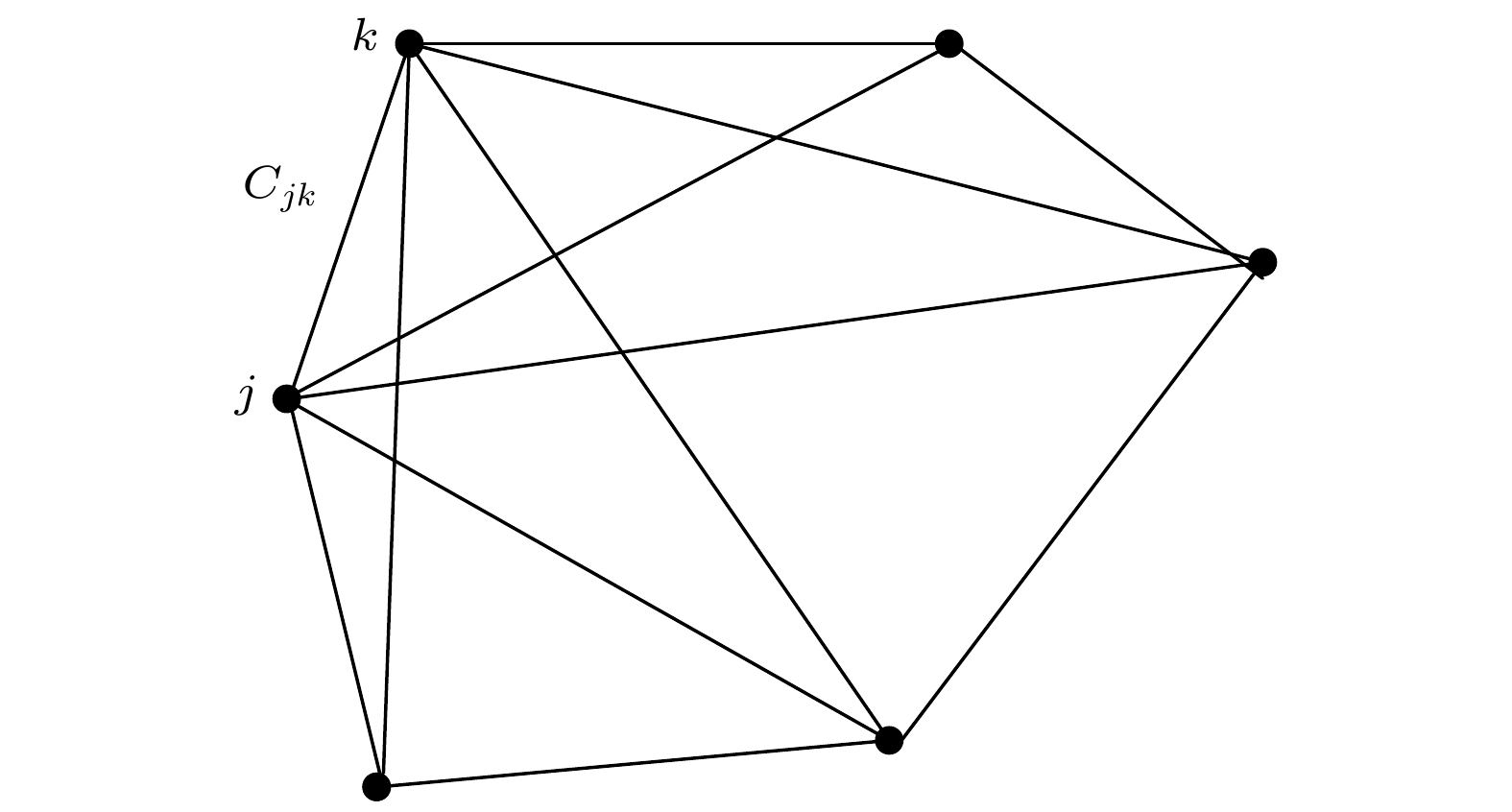
 下载:
下载:

